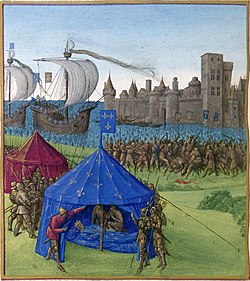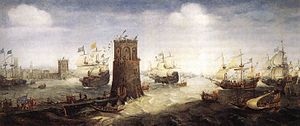 Pope John XXII (Latin: Ioannes XXII; 1244[1] – 4 December 1334), born Jacques Duèze (or d'Euse), was Pope from 7 August 1316 to his death in 1334.
Pope John XXII (Latin: Ioannes XXII; 1244[1] – 4 December 1334), born Jacques Duèze (or d'Euse), was Pope from 7 August 1316 to his death in 1334.
He was the second and longest-reigning Avignon Pope, elected by the Conclave of Cardinals, which was assembled in Lyon through the work of King Louis X's brother Philip, the Count of Poitiers, later King Philip V of France. Like his predecessor, Clement V, Pope John centralized power and income in the Papacy and lived a princely life in Avignon.[2] He opposed the political policies of Louis IV of Bavaria as Holy Roman Emperor, which prompted Louis to invade Italy and set up an antipope, Nicholas V.
Pope John XXII faced controversy in theology involving his views on the Beatific Vision, and he opposed the Franciscan understanding of the poverty of Christ and his apostles, famously leading William of Ockham to write against unlimited papal power[3]. He canonized St. Thomas Aquinas.
---------------------------------------------------------------------------------------------------------------------------
Witch trials in the early modern period

The period of witch trials in Early Modern Europe[1] were a widespread moral panic suggesting that malevolent Satanic witches were operating as an organized threat to Christendom during the 16th to 18th centuries.[2] Those accused of witchcraft were portrayed as being worshipers of the Devil, who engaged in such acts as malevolent sorcery at meetings known as Witches' Sabbaths. Many people were subsequently accused of being witches, and were put on trial for the crime, with varying punishments being applicable in different regions and at different times.
Though some of the earliest trials are from the Late Medieval period following Pope Innocent VIII's issue of the Summis desiderantes affectibus, which recognized the existence of witches and gave full papal approval for the inquisition to move against witches, the peak of witch hunting was during the European wars of religion, climaxing from 1580 to 1630. The witch hunts declined in the early 18th century, culminating with the British Witchcraft Act of 1735, but there were sporadic witch-trials during the second half of the 18th century, the last known dating to 1782[3] (though a prosecution was commenced in Tennessee as recently as 1833).[4][5][6]
An estimated total of 40,000-60,000 people were executed during the witch trials. Among the best known of these trials were the Scottish North Berwick witch trials, Swedish Torsåker witch trials and the American Salem witch trials. Among the largest and most notable were the Trier witch trials (1581–1593), the Fulda witch trials (1603–1606), the Würzburg witch trial (1626–1631) and the Bamberg witch trials (1626–1631).
The sociological causes of the witch-hunts have long been debated. Mainstream historiography sees the reason for the witch craze in a complex interplay of various factors that mark the early modern period, including the religious sectarianism in the wake of the Reformation, besides other religious, societal, economic and climatic factors.






